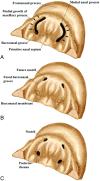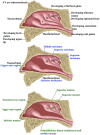Illustrated review of the embryology and development of the facial region, part 1: Early face and lateral nasal cavities
- PMID: 23493891
- PMCID: PMC7965203
- DOI: 10.3174/ajnr.A3415
Illustrated review of the embryology and development of the facial region, part 1: Early face and lateral nasal cavities
Abstract
The early embryological development of the face has been reviewed. One repeating theme to note is the serial closing and then the re-opening of a space. This is seen in the separation of the nasal and oral cavities, the nostrils, and in part 2 the developing eyelids fusing and then re-opening. Part 2 will discuss the further facial development as well as the changes in facial bone appearance after birth.
Figures










References
-
- Kim CH, Park HW, Kim K, et al. . Early development of the nose in human embryos: a stereomicroscopic and histologic analysis. Laryngoscope 2004;114:1791–800 - PubMed
-
- Osumi-Yamashita N. Retinoic acid and mammalian craniofacial morphogenesis. J Biosci 1996;21:313–27
-
- Streit A. The preplacodal region: an ectodermal domain with multipotential progenitors that contribute to sense organs and cranial sensory ganglia. Int J Dev Biol 2007;51:447–61 - PubMed
-
- Bossy J. Development of olfactory and related structures in staged human embryos. Anat Embryol (Berl) 1980;161:225–36 - PubMed
Publication types
MeSH terms
LinkOut - more resources
Full Text Sources
Other Literature Sources
